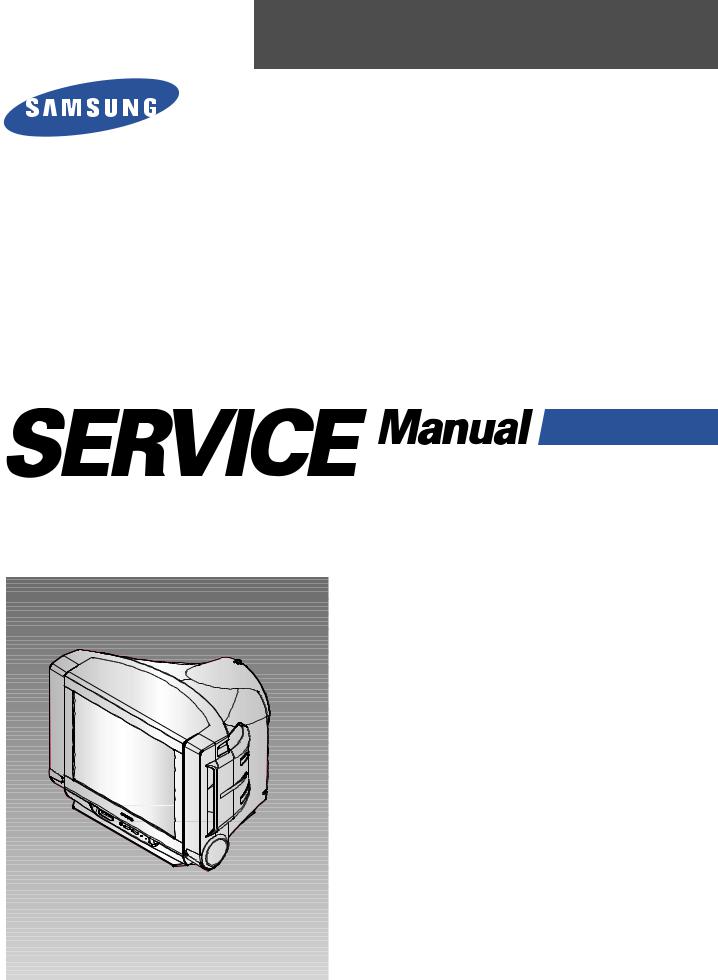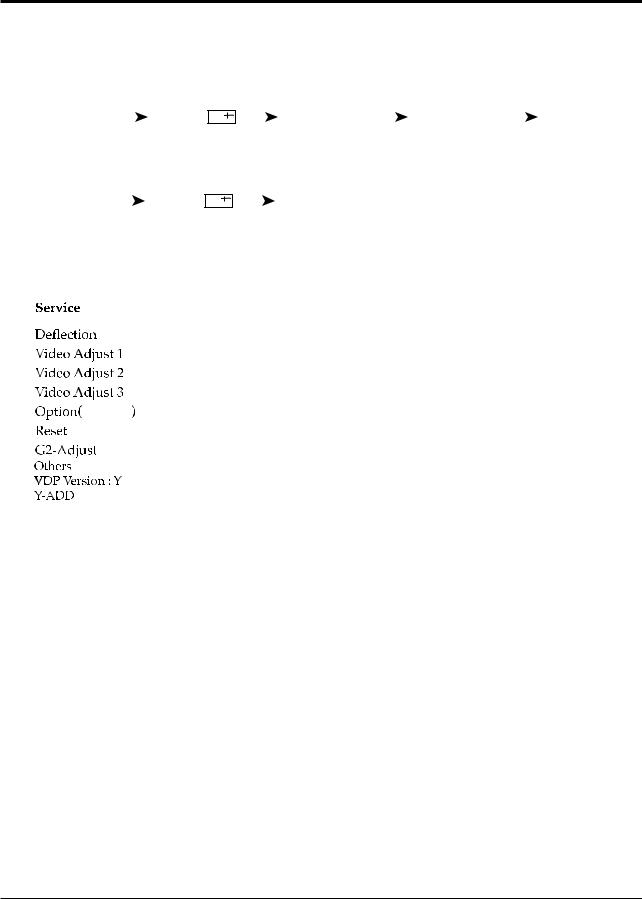Samsung cs21s8nas service manual

COLOR TELEVISION RECEIVER
Chassis : KS2A(P) (Rev. 2)
Model : CS21S8NAS/MUR
COLOR TELEVISION RECEIVER |
|
CONTENTS |
1. Precautions
2. Reference Information
3. Specifications
4. Alignment and Adjustments
5. Troubleshooting
6. Exploded Views and Parts List
7. Electrical Parts List
8. Block Diagrams
9. Wiring Diagram
10. Schematic Diagrams

Precautions
1. Precautions
Follow these safety, servicing and ESD precautions to prevent damage and protect against potential hazards such as electrical shock and X-rays.
1-1 Safety Precautions
1.Be sure that all of the built-in protective devices are replaced. Restore any missing protective shields.
2.When reinstalling the chassis and its assemblies, be sure to restore all protective devices, including: nonmetallic control knobs and compartment covers.
3.Make sure that there are no cabinet openings through which people—particularly children—might insert fingers and contact dangerous voltages. Such openings include the spacing between the picture tube and the cabinet mask, excessively wide cabinet ventilation slots, and improperly fitted back covers.
If the measured resistance is less than 1.0 megohm or greater than 5.2 megohms, an abnormality exists that must be corrected before the unit is returned to the customer.
4.Leakage Current Hot Check (Figure 1-1): Warning: Do not use an isolation transformer during this test. Use a leakagecurrent tester or a metering system that complies with American National Standards Institute (ANIS C101.1, Leakage Current for Appliances), and Underwriters Laboratories (UL Publication UL1410, 59.7).
5.With the unit completely reassembled, plug the AC line cord directly into the power outlet. With the unit’s AC switch first in the ON position and then OFF, measure the current between a known earth ground (metal water pipe, conduit, etc.) and all exposed metal parts, including: antennas, handle brackets, metal cabinets, screwheads and control shafts. The current measured should not exceed 0.5 milliamp. Reverse the powerplug prongs in the AC outlet and repeat the test.
|
|
|
|
|
|
|
|
|
(READING SHOULD |
||
|
|
|
|
|
|
|
|
|
|||
|
|
|
|
|
|
LEAKAGE |
NOT BE ABOVE |
||||
DEVICE |
|
|
|
|
|
CURRENT |
|
0.5mA) |
|||
UNDER |
|
|
|
|
|
TESTER |
|
|
|
||
TEST |
|
|
|
|
|
|
|
|
|
|
|
|
|
|
|
|
|
|
|||||
|
|
TEST ALL |
|
|
|
|
|
|
|
||
|
EXPOSED METAL |
|
|
|
|
|
|
|
|||
|
|
SURFACES |
|
|
|
|
|
|
|
||
2-WIRE CORD |
|
|
|
|
|
|
|
||||
ALSO TEST WITH |
|
|
|
|
|
|
|
||||
PLUG REVERSED |
|
|
|
|
|
|
|
|
|||
(USING AC ADAPTER |
|
|
|
|
|
|
|
EARTH |
|||
PLUG AS REQUIRED) |
|
|
|
|
|
GROUND |
|||||
Fig. 1-1 AC Leakage Test
6.Antenna Cold Check:
With the unit’s AC plug disconnected from the AC source, connect an electrical jumper across the two AC prongs. Connect one lead of the ohmmeter to an AC prong. Connect the other lead to the coaxial connector.
7.X-ray Limits:
The picture tube is especially designed to prohibit X-ray emissions. To ensure continued X-ray protection, replace the picture tube only with one that is the same type as the original. Carefully reinstall the picture tube shields and mounting hardware; these also provide X-ray protection.
8.High Voltage Limits:
High voltage must be measured each time servicing is done on the B+, horizontal deflection or high voltage circuits. Correct operation of the X-ray protection
circuits must be reconfirmed whenever they are serviced.
(X-ray protection circuits also may be called “horizontal disable” or “hold-down”.)
Heed the high voltage limits. These include the X–ray Protection Specifications Label, and the Product Safety and X-ray Warning Note on the service data schematic.
Samsung Electronics |
1-1 |

Precautions
1-1 Safety Precautions (Continued)
9.High voltage is maintained within specified limits by close-tolerance, safety-related components and adjustments. If the high voltage exceeds the specified limits, check each of the special components.
10.Design Alteration Warning:
Never alter or add to the mechanical or electrical design of this unit. Example: Do not add auxiliary audio or video connectors. Such alterations might create a safety hazard. Also, any design changes or additions will void the manufacturer’s warranty.
11.Hot Chassis Warning:
Some TV receiver chassis are electrically connected directly to one conductor of the AC power cord. If an isolation transformer is not used, these units may be safely serviced only if the AC power plug is inserted so that the chassis is connected to the ground side of the AC source.
To confirm that the AC power plug is inserted correctly, do the following: Using an AC voltmeter, measure the voltage between the chassis and a known earth ground. If the reading is greater than 1.0V, remove the AC power plug, reverse its polarity and reinsert. Re-measure the voltage between the chassis and ground.
12.Some TV chassis are designed to operate with 85 volts AC between chassis and ground, regardless of the AC plug polarity. These units can be safely serviced only if an isolation transformer inserted between the receiver and the power source.
13.Some TV chassis have a secondary ground system in addition to the main chassis ground. This secondary ground system is not
isolated from the AC power line. The two ground systems are electrically separated by insulating material that must not be defeated or altered.
14.Components, parts and wiring that appear to have overheated or that are otherwise damaged should be replaced with parts that meet the original specifications. Always determine the cause of damage or overheating, and correct any potential hazards.
15.Observe the original lead dress, especially near the following areas: Antenna wiring, sharp edges, and especially the AC and high voltage power supplies. Always inspect for pinched, out-of-place, or frayed wiring. Do not change the spacing between components and the printed circuit board. Check the AC power cord for damage. Make sure that leads and components do not touch thermally hot parts.
16.Picture Tube Implosion Warning:
The picture tube in this receiver employs “integral implosion” protection. To ensure continued implosion protection, make sure that the replacement picture tube is the same as the original.
17.Do not remove, install or handle the picture tube without first putting on shatterproof goggles equipped with side shields. Never handle the picture tube by its neck. Some “in-line” picture tubes are equipped with a permanently attached deflection yoke; do not try to remove such “permanently attached” yokes from the picture tube.
18.Product Safety Notice:
Some electrical and mechanical parts have special safety-related characteristics which might not be obvious from visual inspection. These safety features and the protection they give might be lost if the replacement component differs from the original—even if the replacement is rated for higher voltage, wattage, etc.
Components that are critical for safety are indicated in the circuit diagram by shading,
(  ) or ( ! ).
) or ( ! ).
Use replacement components that have the same ratings, especially for flame resistance and dielectric strength specifications.
A replacement part that does not have the same safety characteristics as the original might create shock, fire or other hazards.
1-2 |
Samsung Electronics |

Precautions
1-2 Servicing Precautions
Warning1: First read the “Safety Precautions” section of this manual. If some unforeseen circumstance creates a conflict between the servicing and safety precautions, always follow the safety precautions.
Warning2: An electrolytic capacitor installed with the wrong polarity might explode.
1.Servicing precautions are printed on the cabinet. Follow them.
2.Always unplug the unit’s AC power cord from the AC power source before attempting to:
(a)Remove or reinstall any component or assembly, (b) Disconnect an electrical plug or connector, (c) Connect a test component in parallel with an electrolytic capacitor.
3.Some components are raised above the printed circuit board for safety. An insulation tube or tape is sometimes used. The internal wiring is sometimes clamped to prevent contact with thermally hot components. Reinstall all such elements to their original position.
4.After servicing, always check that the screws, components and wiring have been correctly reinstalled. Make sure that the portion around the serviced part has not been damaged.
5.Check the insulation between the blades of the AC plug and accessible conductive parts (examples: metal panels, input terminals and earphone jacks).
6.Insulation Checking Procedure: Disconnect the power cord from the AC source and turn the power switch ON. Connect an insulation resistance meter (500V) to the blades of the AC plug.
The insulation resistance between each blade of the AC plug and accessible conductive parts (see above) should be greater than 1 megohm.
7.Never defeat any of the B+ voltage interlocks. Do not apply AC power to the unit (or any of its assemblies) unless all solid-state heat sinks are correctly installed.
8.Always connect a test instrument’s ground lead to the instrument chassis ground before connecting the positive lead; always remove the instrument’s ground lead last.
Samsung Electronics |
1-3 |

Precautions
1-3 Precautions for Electrostatically Sensitive Devices (ESDs)
1.Some semiconductor (“solid state”) devices are easily damaged by static electricity. Such components are called Electrostatically Sensitive Devices (ESDs); examples include integrated circuits and some field-effect transistors. The following techniques will reduce the occurrence of component damage caused by static electricity.
2.Immediately before handling any semicon ductor components or assemblies, drain the electrostatic charge from your body by touching a known earth ground. Alternatively, wear a discharging wrist-strap device. (Be sure to remove it prior to applying power— this is an electric shock precaution.)
3.After removing an ESD-equipped assembly, place it on a conductive surface such as aluminum foil to prevent accumulation of electrostatic charge.
4.Do not use freon-propelled chemicals. These can generate electrical charges that damage ESDs.
5.Use only a grounded-tip soldering iron when soldering or unsoldering ESDs.
6.Use only an anti-static solder removal device. Many solder removal devices are not rated as “anti-static”; these can accumulate sufficient electrical charge to damage ESDs.
7.Do not remove a replacement ESD from its protective package until you are ready to install it. Most replacement ESDs are packaged with leads that are electrically shorted together by conductive foam, aluminum foil or other conductive materials.
8.Immediately before removing the protective material from the leads of a replacement ESD, touch the protective material to the chassis or circuit assembly into which the device will be installed.
9.Minimize body motions when handling unpackaged replacement ESDs. Motions such as brushing clothes together, or lifting a foot from a carpeted floor can generate enough static electricity to damage an ESD.
1-4 |
Samsung Electronics |

Reference Information
2. Reference Information
2-1 Tables of Abbreviations and Acronyms
Table 2-1 Abbreviations
A |
Ampere |
MV |
Megavolt |
Ah |
Ampere-hour |
MW |
Megawatt |
Å |
Angstrom |
MΩ |
Megohm |
dB |
Decibel |
m |
Meter |
dBm |
Decibel Referenced to One |
µA |
Microampere |
°C |
Milliwatt |
µF |
Microfarad |
Degree Celsius |
µH |
Microhenry |
|
°F |
Degree Fahrenheit |
µm |
Micrometer |
°K |
degree Kelvin |
µs |
Microsecond |
F |
Farad |
µW |
Microwatt |
G |
Gauss |
mA |
Milliampere |
GHz |
Gigahertz |
mg |
Milligram |
g |
Gram |
mH |
Millihenry |
H |
Henry |
mI |
Milliliter |
Hz |
Hertz |
mm |
Millimeter |
h |
Hour |
ms |
Millisecond |
ips |
Inches Per Second |
mV |
Millivolt |
kWh |
Kilowatt-hour |
nF |
Nanofarad |
kg |
Kilogram |
Ω |
Ohm |
kHz |
Kilohertz |
pF |
Picofarad |
kΩ |
Kilohm |
Ib |
Pound |
km |
Kilometer |
rpm |
Revolutions Per Minute |
km/h |
Kilometer Per Hour |
rps |
Revolutions Per Second |
kV |
Kilovolt |
s |
Second (Time) |
kVA |
Kilovolt-ampere |
V |
Volt |
kW |
Kilowatt |
VA |
Volt-ampere |
I |
Liter |
W |
Watt |
MHz |
Megahertz |
Wh |
Watt-hour |
Samsung Electronics |
2-1 |

Reference Information
Table 2-2 Table of Acronyms
ABL |
Automatic Brightness Limiter |
I/O |
Input/output |
AC |
Alternating Current |
L |
Left |
ACC |
Automatic Chroma Control |
L |
Low |
AF |
Audio Frequency |
LED |
Light Emitting Diode |
AFC |
Automatic Frequency Control |
LF |
Low Frequency |
AFT |
Automatic Fine Tuning |
MOSFET |
Metal-Oxide-Semiconductor-Field-Effect-Tr |
AGC |
Automatic Gain Control |
MTS |
Multi-channel Television Sound |
AM |
Amplitude Modulation |
NAB |
National Association of Broadcasters |
ANSI |
American National Standards Institute |
NEC |
National Electric Code |
APC |
Automatic Phase Control |
NTSC |
National Television Systems Committee |
APC |
Automatic Picture Control |
OSD |
On Screen Display |
A/V |
Audio-Video |
PCB |
Printed Circuit Board |
AVC |
Automatic Volume Control |
PLL |
Phase-Locked Loop |
BAL |
Balance |
PWM |
Pulse Width Modulation |
BPF |
Bandpass Filter |
QIF |
Quadrature Intermediate Frequency |
B-Y |
Blue-Y |
R |
Right |
CATV |
Community Antenna Television (Cable TV) |
RC |
Resistor & Capacitor |
CB |
Citizens Band |
RF |
Radio Frequency |
CCD |
Charge Coupled Device |
R-Y |
Red-Y |
CCTV |
Closed Circuit Television |
SAP |
Second Audio Program |
Ch |
Channel |
SAW |
Surface Acoustic Wave(Filter) |
CRT |
Cathode Ray Tube |
SIF |
Sound Intermediate Frequency |
CW |
Continuous Wave |
SMPS |
Switching Mode Power Supply |
DC |
Direct Current |
S/N |
Signal/Noise |
DVM |
Digital Volt Meter |
SW |
Switch |
EIA |
Electronics Industries Association |
TP |
Test Point |
ESD |
Electrostatic Discharge |
TTL |
Transistor Transistor Logic |
ESD |
Electrostatically Sensitive Device |
TV |
Television |
FBP |
Feedback Pulse |
UHF |
Ultra High Frequency |
FBT |
Flyback Transformer |
UL |
Underwriters Laboratories |
FF |
Flip-Flop |
UV |
Ultraviolet |
FM |
Frequency Modulation |
VCD |
Variable-Capacitance Diode |
FS |
Fail Safe |
VCO |
Voltage Controlled Oscillator |
GND |
Ground |
VCXO |
Voltage Controlled Crystal Oscillator |
G-Y |
Green-Y |
VHF |
Very High Frequency |
H |
High |
VIF |
Video Intermediate Frequency |
HF |
High-Frequency |
VR |
Variable Resistor |
HI-FI |
High Fidelity |
VTR |
Video Tape Recorder |
IC |
Inductance-Capacitance |
VTVM |
Vacuum Tube Voltmeter |
IC |
Integrated Circuit |
TR |
Transistor |
IF |
Intermediate Frequency |
|
|
|
|
|
|
2-2 |
Samsung Electronics |

Reference Information
2-2 IC Line Up
Table 2 - 3 IC Line - Up
NO |
BOARD |
LOC. NO |
SPEC |
DESCRIPTION |
REMARK |
|
|
|
IC201S |
VDP3112B |
Video Processor |
Refer to Table 2-3-1 |
|
|
|
|
|
|
|
|
|
|
IC601 |
MSP3410D |
Multistandard Sound Processor |
Refer to Table 2-3-2 |
|
|
|
|
|
|
|
|
|
|
IC901 |
SDA555X |
MICOM, TTX(MTP) |
|
|
|
|
|
|
|
|
|
|
|
IC902 |
KS24L161 |
EEPROM |
|
|
|
|
|
|
|
|
|
|
|
IC602 |
TDA7297 |
Audio AMP |
Refer to Table 2-3-3 |
|
|
|
|
|
|
|
|
|
|
HIC201 |
DRGB001 |
RGB Drive AMP Hybrid IC |
VM Option |
|
|
|
IC301 |
LA7845 |
Vertical IC |
|
|
|
|
Q401 |
KSD5703 |
Horizontal Drive IC |
DH01 |
|
|
|
|
|
|
||
|
|
D409 |
FMP-3FU |
|||
|
|
|
|
|||
|
|
|
|
|
|
|
|
|
IC401 |
KA393 |
E/W Drive IC |
|
|
|
|
Q404 |
IRF620 |
|
||
|
|
|
|
|||
|
|
IC801S |
3S1265RD |
SPS Controllor |
|
|
|
|
3S1265R |
|
|||
|
|
|
|
|
||
1 |
MAIN |
D801S |
RBV606 |
Bridge Diode |
|
|
|
|
PC801S |
PC123Y |
Photo Coupler |
|
|
|
|
IC805 |
KA78R05 |
5V Controlled Regulator |
|
|
|
|
|
|
|
|
|
|
|
D806 |
FML-G12S |
Rectifier Diode |
DDR01 |
|
|
|
D807 |
F10V20S |
|||
|
|
|
|
|||
|
|
|
|
|
|
|
|
|
D805 |
FMG-G26S |
|
|
|
|
|
F10V60S |
|
|
||
|
|
IC804 |
KA7806 |
6V Regulator |
|
|
|
|
|
|
|
|
|
|
|
IC803 |
KA78R08 |
8V Controlled Regulator |
|
|
|
|
|
|
|
|
|
|
|
IC903 |
KA78RM33 |
3.3V Regulator |
|
|
|
|
|
|
|
|
|
|
|
IC904 |
KIA7025AP |
MICOM Reset IC |
|
|
|
|
|
|
|
|
|
|
|
Q909 |
2N7000 |
IIC Level Shifter |
|
|
|
|
|
|
|||
|
|
Q910 |
|
|||
|
|
|
|
|
|
|
|
|
TU01 |
TCPS3001PD09D(S) |
Main Tuner with IF Block |
Refer to Table 2-3-4 |
|
|
|
|
|
|
|
|
|
|
D813 |
FML-G12S |
Rectifier Diode |
|
|
|
|
|
|
|
|
|
Samsung Electronics |
2-3 |

Reference Information
Table 2 - 3 IC Line - Up
NO |
BOARD |
LOC. NO |
SPEC |
DESCRIPTION |
REMARK |
|
|
IC501 |
|
|
PCB Version |
|
|
|
TDA6101Q |
Video Output AMP R.G.B Drive |
|
|
|
IC502 |
|||
|
|
A,B,C,D |
|||
|
|
|
|
|
|
|
CRT |
IC503 |
|
|
|
2 |
|
|
|
|
|
|
IC501 |
STV5109 |
Video Output AMP R.G.B Drive |
PCB Version |
|
|
|
||||
|
|
|
F,G,H,J |
||
|
|
|
|
|
|
|
|
|
|
|
|
3 |
V-S/W |
ICS01 |
TEA6425 |
Video Switching IC with Adder Output |
Option |
|
|
|
|
|
|
4 |
PIP |
ICP01 |
SDA9488X |
High-end Picture-In Picture IC |
Option |
|
|
|
|
|
|
2-4 |
Samsung Electronics |

|
|
|
Reference Information |
Table 2-3-1 VIDEO IC |
|
|
|
|
|
|
|
SPEC |
|
FUNCTION |
REMARK |
|
|
|
|
VDP3112B |
|
50Hz Basic 1H Comb Filter |
|
|
|
|
|
VDP3130Y-B2 |
|
50Hz, 2H Comb Filter, DVD Input |
|
|
|
|
|
Table 2-3-2 SOUND IC |
|
|
|
|
|
|
|
SPEC |
|
FUNCTION |
REMARK |
|
|
|
|
MSP3400D |
|
Multistandard, A2 Stereo, Equalizer, 2 Scart, RCA9P |
|
|
|
|
|
MSP3410D |
|
Multistandard, A2 Stereo, Nicam, Equalizer, 2 Scart, RCA9P |
|
|
|
|
|
MSP3405D/BSP3505D |
|
Multistandard, Line-Stereo, Mono, RCA9P |
|
|
|
|
|
Table 2-3-3 SOUND AMP |
|
|
|
|
|
|
|
SPEC |
|
FUNCTION |
REMARK |
|
|
|
|
TDA7297 |
|
15W x 2CH, 10W x 2CH |
|
|
|
|
|
TDA7266S |
|
5W x 2CH |
|
|
|
|
|
Table 2-3-4 TUNER |
|
|
|
|
|
|
|
SPEC |
|
FUNCTION |
REMARK |
|
|
|
|
TCPS3001PD09A(S) |
|
CS, Stereo |
IF IC = Sanyo |
|
|
|
|
TCPS3001PD09D(S) |
|
CS, Stereo |
IF IC = Philips |
|
|
|
|
TCPS3001PD09C(S) |
|
CS, Stereo, India |
|
|
|
|
|
TAFC-Z141D |
|
CS, Stereo |
|
|
|
|
|
Table 2-3-5 HORIZONTAL DRIVE IC (Q401)
SPEC |
FUNCTION |
REMARK |
|
|
|
KSD5703 |
50Hz, With EW Model |
|
|
|
|
KSC5386 |
50Hz, W/O EW Model |
|
|
|
|
Samsung Electronics |
2-5 |

MEMO
2-6 |
Samsung Electronics |

Specifications
3. Specifications
Television |
CS |
PAL/SECAM-B/G,D/K,I, NTSC-M |
Depending on Tuner |
|
System |
CZ |
PAL/SECAM-B/G,D/K,I, NTSC4.43 |
||
|
||||
|
|
|
|
|
Antena Input |
75ohms, Coaxial Cable |
|
||
|
|
|
|
|
|
Consumption |
65W (Applied When 21” Flat) |
|
|
|
|
|
|
|
Power |
Requirements |
220V Only |
|
|
|
|
|||
Free Voltage |
Not Present R815 |
|||
|
|
|||
|
|
|
|
|
|
Frequency |
50/60Hz |
|
|
|
|
|
|
|
|
|
15W x 2CH |
|
|
|
Output |
|
|
|
|
10W x 2CH |
|
||
|
|
|
|
|
Sound |
|
5W x 2CH |
|
|
|
|
|
||
|
Effect |
Turbo Sound |
|
|
|
|
|
||
|
Pseudo Stereo |
|
||
|
|
|
||
|
|
|
|
|
|
|
RCA Input |
|
|
|
Front |
|
|
|
|
S-VHS |
Option |
||
|
(AV2) |
|||
|
|
|
||
|
Head-Phone |
|
||
|
|
|
||
|
|
|
|
|
|
|
|
AV1 : Scart I/O, RGB Input, |
|
Jacks |
|
2Scart Input/Output |
RF Out |
|
|
|
AV2 : Scart I/O, Monitor Out |
||
|
|
|
||
|
|
|
|
|
|
Back |
DVD Input(YPbPr) |
Option |
|
|
|
|
||
|
|
|
AV1: Video/Audio-R/Audio-L |
|
|
|
RCA Input/Output |
AV2: Video/Audio-R/Audio-L |
|
|
|
Monitor Out : Video/Audio- |
||
|
|
|
||
|
|
|
R/Audio-L |
|
|
|
|
|
|
|
|
S-VHS |
Option |
|
|
|
|
|
|
Specifications are subject to change.
Samsung Electronics |
3-1 |

MEMO
3-2 |
Samsung Electronics |

Alignment and Adjustments
4. Alignment and Adjustments
4-1 General Alignment Instructions
1.Usually, a color TV-VCR needs only slight touch-up adjustment upon installation. Check the basic characteristics such as height, horizontal and vertical sync and focus.
2.Observe the picture for good black and white details. There should be objectionable color shading; if color shading is present, demagnetize, perform purity and convergence adjustments described below.
3.Use the specified test equipment or its equivalent.
4.Correct impedance matching is essential.
5.Avoid overload. Excessive signal from a sweep generator might overload the front-end of the TV. When inserting signal markers, do not allow the marker generator to distort test results.
6.Connect the TV only to an AC power source with voltage and frequency as specified on the backcover nameplate.
7.Do not attempt to connect or disconnect any wires while the TV is turned on. Make sure that the power cord is disconnected before replacing any parts.
8.To protect against shock hazard, use an isolation transformer.
4-2 Automatic Degaussing
A degaussing coil is mounted around the picture tube, so that external degaussing after moving the TV should be unnecessary. But the receiver must be properly degaussed upon installation.
The degaussing coil operates for about 1 second after the power is switched ON. If the set is moved or turned in a different direction, the power should be OFF for at least 10 minutes.
If the chassis or parts of the cabinet become magnetized, poor color purity will result. If this happens, use an external degaussing coil. Slowly move the degaussing coil around the faceplate of the picture tube and the sides and front of the receiver. Slowly withdraw the coil to a distance of about 6 feet before turning power OFF.
If color shading persists, perform the following Color purity and Convergence adjustments.
4-3 High Voltage Check
CAUTION : There is no high voltage adjustment on this chassis. The B+ power supply should be +135 volts (with full colorbar input and normal picture level).
1.Connect a digital voltmeter to the second anode of the picture tube.
2.Turn on the TV. Set the Brightness and Contrast controls to minimum (zero beam current).
3.Adjust the Brightness and contrast controls to both extremes. Ensure that the high voltage does not exceed 30 KV under any conditions.
Samsung Electronics |
4-1 |

Alignment and Adjustments
4-4 FOCUS Adjustment
1.Input a black and white signal.
2.Adjust the tuning control for the clearest picture.
3.Adjust the FOCUS control for well defined scanning lines in the center area of the screen.
4-5 SCREEN Adjustment
1.Input Toshiba Pattern
2.Enter “Service Mode”.(Refer to “4-8-1 Service Mode”)
3.Select “G2-Adjust”.
4.Set the values as below.
Table 1. Screen Adjustment Table
|
|
IBRM |
WDRV |
|
CDL |
COLR G B |
|
||||
No |
INCH / CRT |
|
|
|
|
|
|
|
(Smallesz Value) |
REGION |
|
6101 |
5109 |
6101 |
5109 |
6101 |
|
5109 |
6101 |
5109 |
|||
|
|
|
|
||||||||
1 |
14” / SDI |
205 |
205 |
35 |
35 |
100 |
|
100 |
100 |
100 |
Noraml |
|
|
|
|
|
|
|
|
|
|
|
|
2 |
15PF / SDI |
220 |
225 |
35 |
35 |
200 |
|
160 |
65 |
100 |
|
|
|
||||||||||
|
|
|
|
|
|
|
|
|
|
||
215 |
215 |
35 |
35 |
100 |
|
100 |
100 |
100 |
CIS |
||
|
|
|
|||||||||
|
|
|
|
|
|
|
|
|
|
|
|
3 |
21” 1.7R / SDI |
220 |
215 |
35 |
45 |
230 |
|
160 |
65 |
80 |
|
4 |
21” 1.7R / JCT |
220 |
220 |
35 |
35 |
200 |
|
200 |
150 |
150 |
|
|
|
|
|
|
|
|
|
|
|
|
|
5 |
21PF / TSB |
220 |
225 |
35 |
45 |
230 |
|
185 |
65 |
75 |
Noraml |
|
|
|
|
|
|
|
|
|
|
|
|
6 |
21PF / LG |
230 |
225 |
35 |
45 |
230 |
|
175 |
65 |
165 |
|
|
|
||||||||||
|
|
|
|
|
|
|
|
|
|
|
|
7 |
21PF / SDI |
220 |
220 |
35 |
35 |
230 |
|
200 |
65 |
145 |
|
8 |
25PF / SDI |
210 |
205 |
35 |
45 |
150 |
|
150 |
65 |
140 |
|
|
|
|
|
|
|
|
|
|
|
|
|
9 |
29” 1.3R / SDI |
220 |
200 |
35 |
45 |
180 |
|
180 |
65 |
150 |
|
|
|
|
|
|
|
|
|
|
|
|
|
10 |
25” 1.3R/SDI |
220 |
210 |
35 |
35 |
230 |
|
220 |
65 |
130 |
|
|
|
|
|
|
|
|
|
|
|
|
|
11 |
30” |
210 |
200 |
35 |
45 |
160 |
|
180 |
100 |
130 |
|
|
|
|
|
|
|
|
|
|
|
|
|
5.Turn the SCREEN VR until “MRCR G B” and “MRWDG” are green and those value are about 100. (The incorrect SCREEN Voltage may result that “MRCR G B” and “MRWDG” should be red)
4-2 |
Samsung Electronics |

Alignment and Adjustments
4-6 E2PROM (IC902) Replacement
1.When IC902 is replaced, all adjustment data revert to the initial values. So, all adjustment values when servicing should be readjusted.
2.After IC902 is replaced, connect the AC power supply cord.
3.Turn the power switch ON.
4.In stand-by, warm up the TV for at least 10 seconds.
5.Power on the TV.
4-7 White Balance Adjustment
■Equipment : Color-Analyzer (CA-100)
■Input Signal : Pattern signal (Toshiba pattern)
1.Select STANDARD from the menu.
2.Input an 100% White pattern.
3.Enter the “Service Mode”. (Refer to “4-8 Service Mode”)
4.Warm up the TV set at least for 30 minutes.
5.Input a Toshiba pattern signal.
6.Enter the “Video Adjust1”. (Refer to table 2.)
-Adjust “Sub Contrast” so that Y (luminance) becomes 65 ft ± 3.
-Use “Red Drive” and “ Blue Drive” to adjust High-Light (x : 265, y : 265)
-Adjust “Sub Bright” so that Y (luminance) becomes 1.2ft ± 0.3.
-Use “Red Cutoff” and “Blue Cutoff” to adjust Low-Light (x : 265, y : 265).
7.Adjust CA-100 so that the final adjustment value can be fixed.
8.Use the Channel Up/Down (▲/▼) buttons to move the cursor on the adjustment modes.
9.Use the Volume +/- buttons to change the adjustment value.
Samsung Electronics |
4-3 |

Alignment and Adjustments
Table 2. White Balance Table
|
|
|
|
|
|
|
|
|
|
|
|
|
|
|
|
|
|
High |
|
|
|
|
Low |
|
|
Area |
Inch |
|
|
|
|
|
|
|
|
|
|
|
|
|
|
|
|
|
|
|
|
|
|||
|
X |
Y |
Luminance |
|
X |
Y |
Luminance |
|||||
|
|
|
|
|
||||||||
|
|
|
|
|
|
(ft) |
|
|
|
(ft) |
||
|
|
|
|
|
|
|
|
|
|
|
|
|
|
|
15PF |
265 |
265 |
85 |
|
265 |
265 |
1.8 |
|
||
|
|
|
|
|
|
|
|
|
|
|
|
|
|
|
21” 1.7R |
265 |
265 |
50 |
|
265 |
265 |
1.2 |
|
||
East South Asia |
21PF |
265 |
265 |
60 |
|
265 |
265 |
1.0 |
|
|||
|
|
|
|
|
|
|
|
|
|
|
||
25”1.3R |
265 |
265 |
45 |
|
265 |
265 |
1.0 |
|
||||
|
|
|
|
|||||||||
|
|
|
|
|
|
|
|
|
|
|
|
|
|
|
25PF |
265 |
265 |
40 |
|
265 |
265 |
1.2 |
|
||
|
|
|
|
|
|
|
|
|
|
|
|
|
|
|
29”1.3R |
265 |
265 |
35 |
|
265 |
265 |
1.0 |
|
||
|
|
30” |
265 |
265 |
35 |
|
265 |
265 |
1.0 |
|
||
|
|
|
|
|
|
|
|
|
|
|
|
|
|
|
14” |
290 |
300 |
55 |
|
290 |
300 |
1.8 |
|
||
|
|
|
|
|
|
|
|
|
|
|
|
|
|
|
15PF |
290 |
300 |
85 |
|
290 |
300 |
1.8 |
|
||
Middle East Asia |
21” 1.7R |
290 |
300 |
50 |
|
290 |
300 |
1.2 |
|
|||
|
|
|
|
|
|
|
|
|
|
|
||
21PF |
290 |
300 |
60 |
|
290 |
300 |
1.0 |
|
||||
& Africa |
|
|
||||||||||
|
|
25” 1.3R |
290 |
300 |
45 |
|
290 |
300 |
1.0 |
|
||
|
|
|
|
|
|
|
|
|
|
|
|
|
|
|
25PF |
290 |
300 |
40 |
|
290 |
300 |
1.2 |
|
||
|
|
|
|
|
|
|
|
|
|
|
|
|
|
|
29”1.3R |
290 |
300 |
35 |
|
290 |
300 |
1.0 |
|
||
|
|
30” |
290 |
300 |
35 |
|
290 |
300 |
1.0 |
|
||
|
|
15PF |
272 |
270 |
50 |
|
265 |
266 |
2.2 |
|
||
|
|
|
|
|
|
|
|
|
|
|
|
|
|
|
21PF |
272 |
270 |
50 |
|
265 |
266 |
2.0 |
|
||
CIS |
25” 1.3R |
272 |
270 |
40 |
|
265 |
266 |
2.2 |
|
|||
|
|
25PF |
272 |
270 |
30 |
|
265 |
266 |
2.2 |
|
||
|
|
|
|
|
|
|
|
|
|
|
|
|
|
|
29” 1.3R |
272 |
270 |
30 |
|
265 |
266 |
2.2 |
|
||
|
|
|
|
|
|
|
|
|
|
|
||
|
|
15PF |
292 |
307 |
85 |
|
301 |
311 |
1.8 |
|
||
|
|
|
|
|
|
|
|
|
|
|
||
|
|
21PF |
292 |
307 |
60 |
|
301 |
311 |
1.0 |
|
||
Australia |
|
|
|
|
|
|
|
|
|
|||
25” 1.3R |
292 |
307 |
45 |
|
301 |
311 |
1.0 |
|
||||
|
|
|
|
|
|
|
|
|
|
|
||
|
|
25PF |
292 |
307 |
40 |
|
301 |
311 |
1.2 |
|
||
|
|
29” 1.3R |
292 |
307 |
35 |
|
301 |
311 |
1.0 |
|
||
|
|
|
|
|
|
|
|
|
|
|
|
|
4-4 |
Samsung Electronics |

Alignment and Adjustments
4-8 Factory Adjustment
4-8-1 Service Mode
1.To enter the “Service Mode”, Press the remote-control keys in this sequence : - If you do not have Factory remote-control
|
PICTURE OFF |
|
|
|
|
|
DISPLAY ( |
) |
|
|
|
|
|
MENU |
|
|
|
MUTE |
|
|
PICTURE ON |
||
|
|
|
|
|
|
||||||||||||||||||
|
|
|
|
|
|
|
|
|
|
|
|
|
|
|
|
|
|
|
|
|
|||
- If you have Factory remote-control |
|
|
|
|
|
|
|
|
|
|
|
|
|||||||||||
|
|
|
|
|
|
|
|
|
|
|
|
|
|
|
|
|
|
|
|
|
|||
|
PICTURE ON |
|
|
|
|
|
DISPLAY ( |
) |
|
|
|
|
|
FACTORY |
|
|
|
|
|
|
|
||
|
|
|
|
|
|
|
|
|
|
|
|
|
|
||||||||||
|
|
|
|
|
|
|
|
|
|
|
|
|
|
|
|
|
|
|
|
|
|
|
|
|
|
|
|
|
|
|
|
|
|
|
|
|
|
|
|
|
|
|
|
|
|
|
|
2. After the Service Mode is entered, the initial screen is as shown in the figure below.
xx xx xx * |
* |
These hexa digits are check sum value which |
|
|
depends on the MICOM version. |
|
|
If check sum value is changed, the value of |
|
|
E2PROM Data newly initialed. |
|
|
|
3.Use the Channel Up/Down buttons to move the cursor in the adjustment parameters.
Note :
-When CRT, CRT PCB, FBT, E2PROM (sometimes MICOM) is replaced, the adjustment values should be controlled.
-After the Service adjustment is completed, Do not select “Reset” in the service mode menu. (After above procedure is done, power is on initially and the “Plug and Play” will be operated.)
Samsung Electronics |
4-5 |

Alignment and Adjustments
Area |
Micom Version |
Excluded Model |
|
Main Problems & History of Corrections |
|
|
|
|
|
|
SIM-806EW |
MSP3410 94 58 VERSION |
At the current mass production (MP), MASK is applying |
|
|
(KS2A/KS3A) |
to ks2a/ks3a chassis |
||
|
|
|||
|
|
|
|
|
|
|
|
1. |
Improvement of Secam-L Sound Noise when using MSP3410 |
|
|
|
|
94 58 VERSION |
|
SIM-806EW1 |
|
2. |
Improvement of repetition of SECAM-L in AUTO SEARCH |
EUROPE |
|
3. |
Improvement of the gap between SCART RGB and CVBS image |
|
(KS2A/KS3A) |
|
|||
|
|
|
centers .(Added to RGB SHIFT FACTORY) |
|
|
|
|
|
|
|
|
|
4. |
Correction of Greek OSD |
|
|
|
5. |
Fixation of Zoom Mode Offset Changed in order to adjust in Service |
|
|
|
|
mode. Application of REMASK via an improvement in picture quality |
|
|
|
|
|
|
SIM-806EW2 |
|
Application of REMASK via an improvement in picture quality |
|
|
|
|
|
|
|
OIM-806EW |
|
TOSHIBA OEM MODEL ONLY MICOM (Applied to SEH MP) |
|
|
(KS2A/KS3A) |
|
||
|
|
|
|
|
|
|
|
|
|
|
SIM-806MA |
CONTROL 6KEY,PIP MODEL, |
MTP is used for all models (excluding KS2A 22Q) |
|
|
(KS2A) |
All 22-Q models |
|
|
|
|
|
MTP used for KS2A 22Q models |
|
|
|
|
1. |
VM related items (Delay1,Gain1,Limit,Delay,Coring) Adjust3) |
|
|
|
2. |
Addition of PIP VSPDEL to FACTORY items |
|
|
|
3. |
No color when PIP NTSC 4.43 is received |
Middle |
SIM-806MA1 |
|
4. |
NICAM POP NOISE |
East |
(KS2A/KS3A) |
|
5.Av by channel key added |
|
Asia |
|
|
6.When English is used for the language of Libia models, the Libian |
|
& Africa |
|
|
||
& CIS |
|
|
|
must be added and PROGRAM_OSD box must be reduces (Libian Only) |
|
|
|
7. |
RGB SHIFT/HB START/HB STOP added |
|
|
|
8. |
Countermeasure on RADIATION (Option: Pin49 output software) |
|
|
|
9. |
In NTSC system, a transient phenomenon happens during the channel |
|
|
|
|
|
|
SIM-806MA2 |
Decided to apply MASK |
Correction of Libian about child lock |
|
|
(KS2A/KS3A) |
(June 2001) |
||
|
|
|
||
|
SIM-806MA3 |
|
1. Improvement of SECAM/PAL Color Hysteresis characteristics |
|
|
(KS2A/KS3A) |
|
2. Correction of instantaneous LNA error |
|
|
|
|
|
|
|
SIM-806EA |
Thailand,Vietnam, |
|
|
|
(KS2A) |
PIP MODEL,6-KEY,CONTROL |
|
|
|
SIM-806EAY |
|
MTP used for KS2A |
|
|
|
1. Correction of Thailand/Vietnam OSD problems |
||
|
(KS2A) |
|
||
|
|
|
("Not available", "S-Video") |
|
|
|
|
|
|
|
|
|
1. |
Change of Indonesia sports string |
East |
|
|
2. |
Addtion of VM related items (Delay1,Gain1,Limit,Delay,Coring) |
|
|
|
to Adjust3 |
|
South |
|
|
3. |
Addition of PIP VSPDEL to FACTORY items |
Asia |
|
|
||
|
|
|
|
|
& |
|
|
4. |
Improvement of No Color when PIP NTSC 4.43 is received |
Australia |
SIM-806EA1 |
|
5. |
Improvement of NICAM POP NOISE |
|
(KS2A/KS3A) |
|
||
|
|
6. |
Addition of AV by channel key service |
|
|
|
|
||
|
|
|
7. |
Addition of RGB SHIFT/HB START/HB STOP |
|
|
|
8. |
Addition of countermeasure on RADIATION (Option: pin49 output |
|
|
|
|
software) |
|
|
|
9. |
Transient phenomena when switching CH in NTSC system |
|
|
|
10. In Temperature Low test, the color of SECAM CH' late follows |
|
|
|
|
|
|
4-6 |
Samsung Electronics |

|
|
|
|
Alignment and Adjustments |
|
|
|
|
|
Area |
Micom Version |
Excluded Model |
|
Main Problems & History of Corrections |
|
|
|
|
|
East |
|
|
|
|
South |
SIM-806EA1 |
Checking the improvement |
|
|
Asia |
in quality: Vietnam/Thailand |
|
|
|
(KS2A/KS3A) |
|
|
||
& |
28.Dec.2000 |
|
|
|
|
|
|
||
Australia |
|
|
|
|
|
SIM-806C |
|
Same with MTP (developed in 22 Sep. 2000) |
|
|
(KS2A/KS3A) |
|
||
|
|
|
|
|
|
|
|
1. Improvement of color noise in LOW BURST |
|
|
|
|
2. A sound saw filter switching error happens when changing Manual |
|
|
|
|
|
Color System |
China |
SIM-806C1 |
|
|
(For a PAL channel, when switching NTSC3.58 into Auto) |
|
|
3. Addition of PIP VSPDEL to FACTORY items |
||
|
(KS2A/KS3A) |
|
||
|
|
|
4. Improvement of No Color when PIP NTSC 4.43 is received |
|
|
|
|
5. Addition of RGB SHIFT/HB START/HB STOP |
|
|
|
|
6. Addition of countermeasure on RADIATION (Option: pin 49 output |
|
|
|
|
|
software) |
|
|
|
7. Transient phenomena happens when switching CH' in NTSC system |
|
|
|
|
|
|
|
SIM-806EI |
|
Same with MTP (developed in 6 Sep. 2000) |
|
|
(KS2A/KS3A) |
|
||
|
|
|
|
|
|
|
|
1. |
Addition of PIP VSPDEL to FACTORY items |
|
|
|
2. |
Improvement of No Color when PIP NTSC 4.43 is received |
India |
|
|
3. |
Addtion of RGB SHIFT/HB START/HB STOP |
SIM-806EI1 |
|
4. |
Addition of countermeasure on RADIATION (Option: pin49 output |
|
|
|
|||
|
(KS2A/KS3A) |
|
|
software) |
|
|
|
5. |
Transient phenomena happens when switching CH' in NTSC system |
|
|
|
6. |
In Temperature Low test, the color of SECAM CH' late follows. |
|
|
|
7. |
Addition of woofer to FACTORY items |
|
|
|
8. |
Change of the value of equalizer (Factory Woofer in EQ ON) |
|
|
|
|
|
Samsung Electronics |
4-7 |
